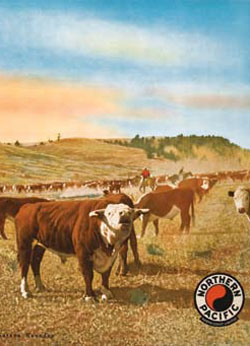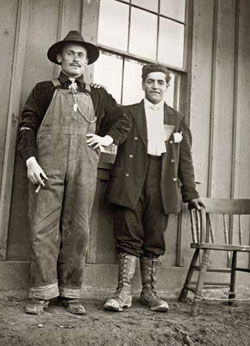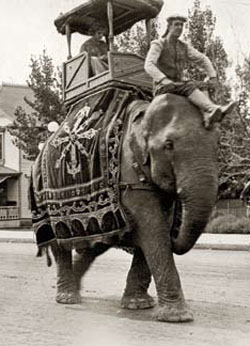Montana: Stories of the Land
Companion Website and Online Teacher's Guide
Chapter 9 - Railroads Link Montana to the Nation, 1881-1915
Chapter 1 - Montana: Where the Land Writes History
Chapter 2 - People of the Dog Days
Chapter 3 - From Dog Days to Horse Warriors
Chapter 4 - Newcomers Explore the Region
Chapter 5 - Beaver, Bison, and Black Robes
Chapter 6 - Montana's Gold and Silver Boom
Chapter 7 - Two Worlds Collide
Chapter 8 - Livestock and the Open Range
Chapter 9 - Railroads Link Montana to the Nation
Chapter 10 - Politics and the Copper Kings
Chapter 11 - The Early Reservation Years
Chapter 12 - Logging in the "High Lonesome"
Chapter 13 - Homesteading This Dry Land
Chapter 14 - Towns Have Lives, Too
Chapter 15 - Progressive Montana
Chapter 16 - Montana and World War I
Chapter 17 - Montanans on the Move
Chapter 18 - The Great Depression Transforms Montana
Chapter 19 - World War II in Montana
Chapter 20 - Building a New Montana
Chapter 21 - A People's Constitution
Chapter 22 - Living in a New Montana
Educator Resources
Educational Trunks
-
East Meets West: The Chinese Experience in Montana from the Montana Historical Society. This trunk explores the lives of the Chinese who came to Montana, the customs that they brought with them to America, how they contributed to Montana communities, and why they left.
Takeaways
-
Inspired by reading specialist Tammy Elser, who was in turn inspired by SKC graduate Taylor Crawford, we've created a "Takeaway" bookmark for every chapter of Montana: Stories of the Land. Before starting a chapter, print and cut out these bookmarks and distribute them to your students. Ask them to use the Takeaway to summarize the GIST of what they learn from reading assigned sections of the chapter. Remind them that they don't have much room, so they'll need to think before they write down the most important idea they want to take away from the section. Learn a little more about the GIST strategy.
-
Even though we've created Takeaways for every chapter, we don't recommend you have your students complete a Takeaway for every section of every chapter they read. That would be exceedingly tedious. However, used appropriately, they can be a useful tool for encouraging reflection and teaching students how to summarize information.
Websites and Online Lesson Plans
-
The Montana Historical Society has created a lesson plan, "Railroads Transform Montana," to complement Chapter 9. The lesson - which includes a PowerPoint presentation - emphasizes the how trains affected the social, economic, and physical landscape of Montana.
-
The Annotated Resource Set “Railroads Link Montana to the Nation, 1881-1915" includes links to photographs, maps, posters, and historic places relating to the role of the railroad in Montana history. Many, but not all, of the images were also used to illustrate Chapter 9 of Montana: Stories of the Land. These sources can be used to build PowerPoints or to create DBQs or other primary-source based activities.
-
These websites provide information on the history of the Great Northern Railway, the Northern Pacific Railroad, and the Milwaukee Road.
-
The American Memory Project has put up maps that document the Indian Land Cessions from 1784-1894 (U.S. Serial Set 4015). You can browse by tribe or by state/territory.
-
There are a number of good lesson plans on the transcontinental railroad (which did not pass through Montana) that touch on themes relevant to Montana. These include "I Hear the Locomotives: The Impact of the Transcontinental Railroad"; the Newberry Library's Historical Maps in the K-12 Classrooms lesson plans for Map 11, and PBS's lesson plan "The Transcontinental Railroad," created to accompany episode five of its eight-part documentary, The West.
-
The lesson plan "An Economic Mystery: What Happened to the Railroads?" asks students to look at the economics of railroading as they investigate the reasons rail companies experienced a crisis in the 1960s and what helped the freight transport portion of the business return to profitability later in the same century.
-
The online Smithsonian exhibit, "America on the Move examines many of the themes discussed in this chapter on a national level.
-
Montana: The Magazine of Western History created discussion guides for articles in its winter 1999 transportation issue, including "The Steamboat and Stagecoach Era in Montana and the Northwest," by Carlos Schwantes and "Something of a Nuisance Value: The Montana, Wyoming, and Southern Railroad," by Jon Axline. They also posted the text (but not the pictures) of the articles in this issue online.
-
Operation Lifesaver has lesson plans and information geared at improving safety around railroad tracks.
-
The University of Montana Special Collections Library has created an online exhibit: Immigrant Montana.
Videos or DVDs
-
From the Far East to the Old West: Chinese and Japanese Settlers in Montana, Mansfield Center for Pacific Affairs - 29 minutes. (Check your library. Copies of the video and study guide were distributed free of charge to all Montana public schools.)
-
"The Grandest Enterprise under God," Episode 5 of the PBS series The West is available for purchase- 84 minutes. (Note: This focuses on the construction of the transcontinental railroad, which did NOT pass through Montana.) Available for purchase via an internet search.
-
American Experience: Transcontinental Railroad - 80 minutes. (Again: this film is NOT specific to Montana.) Available for purchase via an internet search.
Possible Field Trips: View the Map
-
Chief Plenty Coups National Historic Landmark State Park, Pryor. (Related IEFA lesson plans are available.)
Chapter 9 Test and Answer Keys Page
The tests and answer keys are password protected.
You can contact us to receive the password:
- Martha Kohl - call (406) 444-4790 or email mkohl@mt.gov
- Melissa Hibbard - call (406) 444-4741 or email Melissa.Hibbard@mt.gov
Or, if you used the old system, the original username is now the new password. You will be asked for this case-sensitive password every time you open a new document.
Alignment to ELA Common Core Standards
Alignment to Content Standards and Essential Understandings Regarding Montana Indians (EU)




